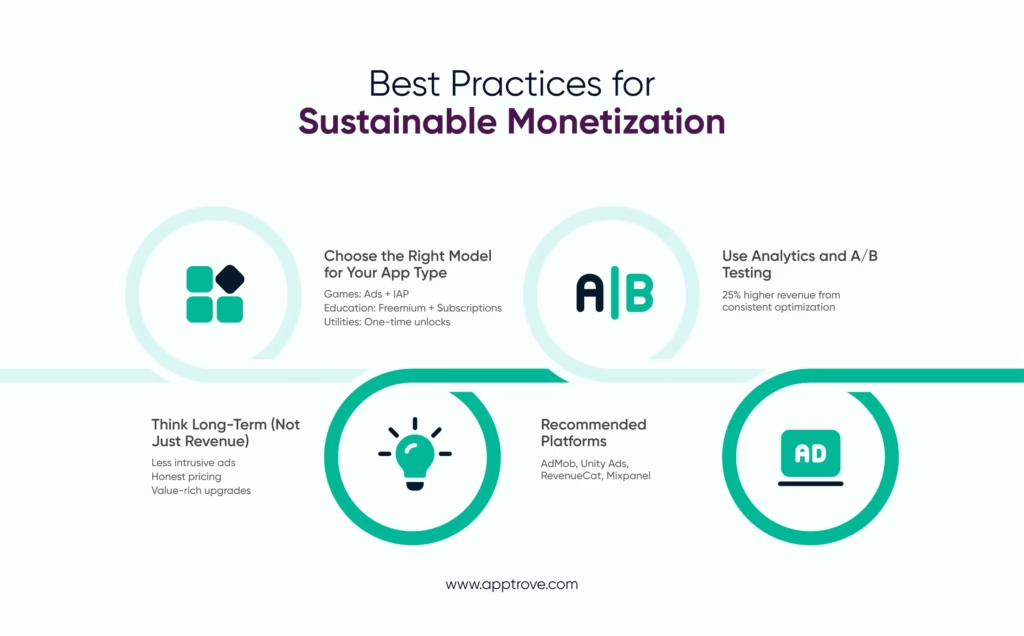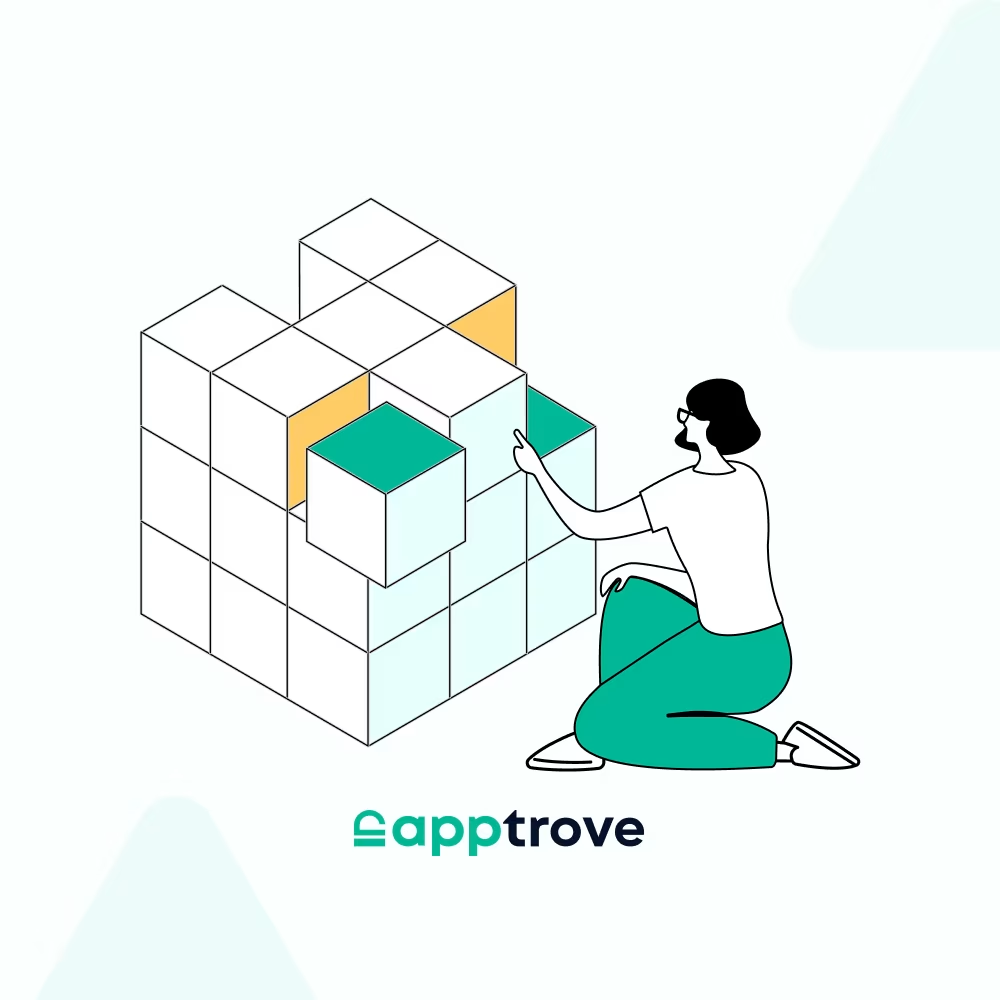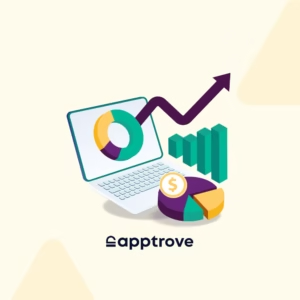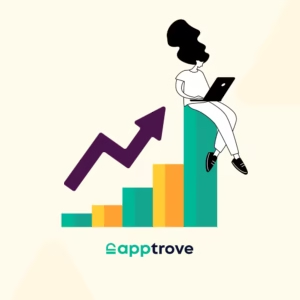Monetization strategies for apps are ways to make money from apps. Typically app developers create apps, for entertainment, education, or professional purposes, with the intent to earn money. Monetization strategies for apps shape the user’s experience. Instead of giving away the app completely for free to no avail, developers will seek to profit while delivering some value to the user.
There are several strategies that developers can use. In the form of ads, subscriptions, in-app purchases, etc. However, with privacy changing over the last several years, particularly in the iOS ecosystem, tools like SKAdNetwork (SKAN) are essential. SKAN makes it possible to measure advertisements and consumer interactions without collecting personally identifiable information. This means advertising and monetization strategies can be fine-tuned with privacy being a focus.
Essentially, app monetization strategies find a healthy balance, keeping the user’s experience intact while benefiting the developer financially.
What is App Monetization?
App monetization is the process of generating revenue from an app. With the increase in the number of people buying smartphones, tablets and computers, there are more apps on the market than ever before. However, simply putting an app in the marketplace is not enough. App creators need revenue models. There are many examples of mobile app monetisation strategies, be it advertising, premium features or charging a fee for the download.
Currently, free apps that use clever app monetization strategies, typically make more money than paid apps. They have access to a greater volume of users and they earn revenue based on in-app purchases, sponsorships, ad views, etc. Creators need to think ahead as to how their app will ultimately earn them a buck because the demand for monetization will only continue to grow.
Importance of Choosing the Right Strategy
Choosing the right monetization strategy is crucial. A good strategy will keep users active and engaged, and most important, retain them longer, and the app will establish a revenue stream that is growing over time. For example, a fun game might use a game monetization strategy that allows for in-game purchases that players can buy, while an educational app monetization strategy may offer some free part of the app, but the rest is paid/completed once the user buys it.
If a wrong monetization strategy is chosen, users will quit or show no willingness to pay. The right app monetization strategy will give users an incentive to stay engaged to make some money, continue users using the app, and allow the app to grow!
Overview of Monetization by Platform
Different apps have different plans. A mobile game may be ad-supported and offer in-app purchases while a desktop app may have a flat fee. Android app monetization strategies will generally use ad networks and the freemium model. While for computer app monetization strategies they may use software licenses or subscriptions. If we look at learning tools for example: monetization strategies for educational apps may use course bundles or charge a fee for a certificate. Remember app monetization platforms – these apps are critical to helping app owners earn an income easily. Each platform has its optimal way of earning money and they all have app monetization strategies.
Mobile App Monetization Strategy
When a person builds an app, they normally want to make money. This is where app monetization strategies come in. App monetization strategies are used to help app developers try to figure out how to monetize their app, but not frustrate users too much with ads or charge them too much money. If you are creating a game app for fun, a learning app or an educational app, or a utility app, the strategy you use will help turn clicks into cash! Let’s explore best practices for how mobile apps can monetize in uncomplicated and painless ways.

In-App Advertising
One of the simplest monetization techniques for an app is advertising displayed within the app. Advertising comes in many forms:
• Banner ad – a small advertisement at the top or bottom of your screen
• Interstitial ad – a larger ad displayed on the entire screen at moments within the app (ex. at the end of a level of a game)
• Rewarded video ad – short videos that users choose to watch (max 30s) to earn something (ex. coins in a game or life in a game)
This work the best is for high-usage apps as more users generally means more advertisement views and revenue to the developer.
Freemium and In-App Purchases
A common approach that comes from there is known as “freemium.” These apps are free to download, but pay for additional features. For example, a photo app may provide some filters for free, but may require a payment to use premium filters. A game may allow users to buy templates and/or skins or pumps.
Using this type of monetization strategy allows apps to build quickly; if it’s free, more people will try it out, and eventually pay for it. Freemium is also played out in the game monetization strategy and monetization strategies for educational apps, where-users pay for levels and/or lessons.
Subscriptions and Affiliate Models
Some apps use a monthly or yearly plan. Think of a music app, where you pay to listen without ads. These types of app monetization strategies provide them with continuous money on a monthly basis.
Another example is affiliate marketing. Apps show products and/or services from other people to the user. If the user buys any of those, the app owner receives a percentage of the money. These types of tactics can also work for Android App Monetization Strategies and for computer app monetization strategies as most of the time users will simply subscribe or purchase whatever you show them in your app.
Apps usually use service-type tools called app monetization platforms that can manage their ads or purchases and also show how much revenue was made from every ad and or purchase. Using some of these types of tools will help make monetizing the app much more seamless and smooth.
Utilizing the right app monetization strategies can help catapult your app and also keep your users happy.
Android App Monetization Strategies
Developing an app is exhilarating. Making money off your app is just as rewarding! That’s where app monetization strategies come into play. App monetization strategies allow developers to create revenue streams from their apps. Whether your app is a game, an educational app or a productivity app, picking the right app monetization strategy is important. Let’s take a look at some of the most widely used and successful ways to monetize Android apps.
Google AdMob and Other Ad Networks
Advertising is one of the most common strategies for Android app monetization, and Google AdMob is ideal for this because it allows developers to display ads in their apps and get paid, either when users view ads or click on them. Developers can select from banner, video or full-screen ads. While AdMob is the most popular and largest, there are other ad networks, including Unity Ads and Facebook Audience Network, which allow developers to display ads similar to AdMob.
These ad networks, which are tied to certain platforms for earning money, are simple to implement and can be added in a few lines of code. They provide developers an opportunity to earn money quickly, where apps might have a large user base.
In-app billing and Subscriptions
Selling digital goods in-app can be a strong mobile app monetization model as well. This is called in-app billing. For example, a game might sell extra lives or special powers for a reasonable fee. The Android platform supports this model natively with Google Play Billing.
Subscriptions are another well-known in-app billing model. Consider apps that cost a user monthly or yearly, to access premium features. This method can provide a more consistent income stream over time.
Android-Specific Opportunities and Challenges
Thanks to Android’s vast global reach, your app has the chance to touch millions of lives. This is one of the key benefits. Android also offers relatively more flexibility in the way apps look and work, which is helpful when it comes to customization.
The only real downside for Android is fragmentation; there are so many devices and versions of Android that all need to be supported, which makes it hard to ensure a consistent experience across the board.
When deciding which game monetization strategy to use, or any way to monetize, consider the type of app you want to build, as well as your target audience. Monetizing an educational app for example is probably different than monetizing a game, and using monetization platforms for apps wisely is a surefire way to enhance your overall earning potential.
To sum up, applying the right app monetization strategies can make your idea a profitable reality!
Game Monetization Strategy
In the fast-paced and fierce mobile and computer gaming industry, having effective app monetization strategies is extremely important for both profitability and sustainability. An effective game monetization strategy will generate revenue while also increasing the engagement and retention of players. Here are three well-known models that game developers can leverage to measure the user’s time and still provide them value.
In-App Purchases and Virtual Goods
In-app purchases are one of the most commonly used approaches in mobile app monetization strategy. It includes anything from virtual items (character skins, weapon upgrades, or power-ups) to customization items. This monetization model speaks to the desire of players to make the game their own and gain advantages. In-app purchases provide scalable revenue, especially in Android app monetization strategies, allowing players to choose how much they want to spend based on preference and how often they play. It is a flexible way to monetize that can be used in computer app monetization strategy as well, allowing players to purchase downloadable content (DLC) or expansion packs.
Ad-Based Revenue
Advertising is one of the most popular monetization methods in free-to-play games. Using rewarded video ads to offer users in-game rewards for viewing, interstitial ads, and banners are common ad formats that can be incorporated into games without interrupting gameplay. This monetization model does not require any initial purchases by users, allowing monetization to reach a wider audience. Using an ad mediation platform from top app monetizing companies can maximize developers’ ad performance and revenue.
Subscription, Battle Pass, and Seasonal Content
Subscription and battle pass models as recurring revenue approaches are becoming increasingly popular. These models deliver (exclusive game content) for a fee and offer players incentives (exclusivity, seasonality, early access) as a reward for their loyalty. Recurring revenue approaches benefit developers by generating engagement over time and recurring income. Additionally, limited-time events and seasons promote the desire to play regularly, creating urgency and excitement, which increases in-game spending.
In conclusion, using/applying and using combos of app monetization methods (subscription, milestones, and virtual goods) creates the greatest chance of success. The approach may be different to the monetization strategies for instructional apps, however, the principle is the same: provide value while developing sustainable revenue models. Every game monetization strategy should work to maximize the user experience while maximizing earnings with smart and thoughtful design choices.
App Monetization Platforms
When it comes to implementing app monetization strategies, you have to make sure that you use the right platform along with your revenue model. Regardless of whether you are focusing on games, educational, or utility apps, the right app monetization platforms can positively affect your revenue and user engagement. Below is an overview of the biggest players, their strengths, and how you can decide the best one for your app.
Top Platforms Overview
Many app monetization platforms have become commonplace among developers within Android, iOS, and desktop environments. Google AdMob, a platform with strong ties to Google services, is widely used due to its analytics capabilities and ease of access. Unity Ads is popular among games (especially mobile games) due to an Ad SDK that is more appropriate for the video style of ads that is most useful for games. Facebook Audience Network is a powerful platform, with superior targeting due to its social data capabilities and is very powerful with niche audiences. The aforementioned platforms will be crucial in executing a successful mobile app monetization plan across application types.
Pros and Cons of Major Platforms
Every platform has its advantages and disadvantages. Google AdMob has great fill rates and a large base of advertisers, but they can be very strict with their content policies. Unity Ads has great, immersive ad formats which are perfect for a game monetization strategy, but may not be right for non-game apps. Facebook Audience Network has rich user targeting, but for smaller teams integration and data compliance can be hard. These types of things are very important in developing your overall app monetization strategies.
Platform Selection Criteria
When choosing a platform, consider your app category, audience demographic, and the experience you want to create for users. For example, educational app monetization strategies may prefer non-intrusive/obtrusive methods and child-friendly networks while Android app monetization strategies may prefer compatibility with their operating system and large inventory of ads. Similarly, developers who monetize computer apps need platforms that promote desktop ad delivery and provide analytics. Finding the right matches between your objectives and the capabilities of the platform will create a scalable and user-friendly monetization model.
Once developers find the right platform and optimize their app monetization strategies they establish a relationship that serves as a powerful engine to develop and grow revenue, allowing developers to achieve ethical and effective monetization within competitive digital environments.
Comparative Analysis of Monetization Strategies
Selecting an effective app monetization strategy is critical in making your app a sustainable business. However, what works well for one type of app may not be appropriate for another. This section reviews the most relevant app monetization strategies and compares them based on various goals and types.

Revenue vs. Retention
Managing user experience with revenue
While showing ads or charging users can increase revenue, it can also frustrate users and drive them away. Therefore, it is essential to learn how to balance revenue generation with user satisfaction. As a point of comparison, apps that utilize rewarded video advertisements (as currently deployed by many games) achieve about 40% greater retention than apps that use ads that pop up in interruption mode.
In my experience, app monetization strategies that provide value (e.g. subscriptions or understanding in-app purchases) are generally more useful in retaining users than advertising-based strategies.
Strategy Suitability by App Type
What works best for games, education, tools and more?
- Games: The most popular app monetization strategy for games is a combination of ads and IAP (in-app purchases). For example, one game, Clash of Clans, generated more than $1.5 billion a year in IAPs.
- Education apps: The prevalent monetization strategy for educational apps is freemium or subscriptions. For example, Duolingo has a freemium app with 5 million paid subscribers.
- Utility tools: Lots of utility tools (such as PDF editing apps or VPNs) come with limited free use and then pay-to-unlock features, so this is a great monetization strategy for computer apps, and works well for Android apps.
Examples from real-world case studies of the top apps.
- Spotify: uses a freemium + subscription mobile app monetization strategy. Over 40% of Spotify users convert to paid plans.
- Candy Crush: has ads and in-app purchases. Generated over $600 million in a single year.
- Google Drive: A fantastic example of an Android app monetization strategy, as it provides limited free storage, but you pay for additional storage upgrades.
Choosing the right app monetization platform (AdMob, Unity Ads, RevenueCat etc.) also plays a key role in how successful your app will be, and should be influenced by the type of app you are creating and who your target audience is.
Regional Considerations in App Monetization
Countries vary in the way they utilize apps, and that means your app monetization strategies should also vary by where your users are. Whether you’re developing for the U.S., India, or Brazil, understanding how users use those apps and how payments are handled can improve profits and user experience.
Trends in Emerging vs. Developed Markets
User behaviour and app revenue models
Users in developed markets, such as the U.S., are more often willing to pay for subscriptions. According to Statista, “App revenue in the U.S. hit $167 billion in 2023, most of which was in-app purchases, subscriptions, or other types of payments.” In contrast, developing markets, like India or Indonesia, often have users who are more comfortable using free apps, funded by ads and not able to pay subscriptions. These are ideal for mobile app monetization strategies that are ad-based (including rewarded video ads). Additionally, in many developing markets, data costs may be a factor. Lightweight applications that do not use as many ads typically perform best in those markets.

Localization and Payment Preferences
Consumers in different areas prefer different types of payment. In Japan, individuals are more likely to use carrier billing, in Europe, people are more frequently using credit cards and PayPal and in places like Nigeria or Kenya, people like mobile money.
So when considering Android app monetization strategies, be sure to offer all the localized payment options available to you (Razorpay in India, M-Pesa in Africa), for example. Educational apps – just like BYJU’S, for future potential app monetizers in the education space, were able to refine their monetization methods for educational apps, which included low-cost subscriptions and regional language options.
When it comes to localization, it’s not just language it’s understanding what is important to people. For example, if you have a productivity app depending on a computer app monetization strategy, and you know we are going to be different rates in the U.S. Vs. Southeast Asia. You should consider how you price in these regions.
Regulations and Compliance
Every region has its own rules. For instance. In the EU, GDPR affects your handling of user data for app monetization platforms. In China, foreign apps are required to partner with a local company. If you don’t at the very minimum work around these you risk being banned or fined.
Even games need to be careful – game monetization strategies need to avoid the use of “loot boxes” or similar conceptions in regions such as Belgium due to gambling regulations.
Future Trends in App Monetization
With user expectations rising and competition thicker, developers will need to reconsider their monetization app revenue strategies. It will all be in balance whereby you, the developer, must balance profit against user experience,and technical advancement against simplicity.
Hybrid Monetization Models
Combining ads, purchases, and subscriptions
One of the most powerful app monetization models in the future is the hybrid model. Instead of having to choose between ads, in-app purchases, or subscriptions, many of the most successful apps combine them all. For example, a common game monetization model is to have free gameplay with optional ad views and a premium purchase option. In addition, App Annie reports that apps with more monetization methods earned an additional 30% more revenue than apps with only one monetization method.
The model works really well with mobile app monetization strategy plans because it allows users to pick how they want to support the app (with time, money or both).
AI, Personalization, and Blockchain
Smart targeting and emerging tech like NFTs
The emergence of artificial intelligence (AI) and machine learning is transforming app monetization platforms. AI can help an app display the right ad or offer to the right person at the right time, thus maximizing revenue while improving user experience. Companies claim personalization can improve in-app purchase conversion rates by 20%.
Blockchain is coming into play also. Some apps – particularly in gaming – are now incorporating digital collectables (NFTs) within their Android app monetization strategy, allowing for another source of revenue while making the app more interactive.
Preparing for Subscription Fatigue
With so many apps expecting to be paid for every month, it isn’t surprising that consumers are starting to feel “subscription fatigue.” It has been said many times before: that apps looking for recursive revenue must offer more value or allow for more freedom. One way to combat this is to allow people to make smaller, one-time purchases rather than commit to a monthly fee. This is also a good instructional app monetization strategy–one-time payments are great, especially if you have engaged users who desire repeated access for only a few dollars.
Educational apps are evolving like everyone else. Consider the educational app monetization strategies that include group family plans. These types of subscriptions allow access by more users at a fraction of the monthly price. Not only are subscriptions structured based on total users but also have implications for retention and growth; smart pricing gives you an edge!
To summarize, the most successful educational app monetization strategies will be smart, flexible and user-friendly. Strong app monetization strategies will keep your revenue high without stunting your users.
Conclusion and Best Practices
Building an app that is successful is not only about the features, it is about the monetization strategies that are going to increase revenues while not alienating users. So let’s recap everything we have summarized as well as some recommendations for implementing it in the real world.
Strategy Summary
Different applications have different strategies. For example, games likely want to utilize a mix of ads and in-app purchases to make money, while educational applications can use freemium or a group subscription, two of the top monetization strategies for educational applications.
If you’re building a mobile-first product, your mobile app monetizing strategy should be lightweight, adaptable, and able to work across devices. For tools or desktop applications, a computer app monetization strategy like pay-to-unlock or limited trials would be appropriate. Reward-based advertising and localization, which cater to local prices, are some of the winning monetization strategies for Android apps.
Continuous Optimization
The significance of A/B testing and analytics
No matter how flawless the plan, it will fail without testing. A/B testing helps you discover what works. For instance, you could test two ads and see when a user clicks on, them and hangs around, longer. Apps that don’t stop A/B testing their app monetization models generate up to 25% more revenue.
Use Firebase, Mixpanel or other great app monetization platforms to help track user preferences and show points of drop-off.
Sustainable monetization
Keeping users happy, while also making money.
The objective is not simply to make money; it is to create an app that users appreciate and will continue to use. When using different app monetization techniques and A/B testing, consider removing as many ads as possible, ensuring that purchases provide substantive value and being upfront about the app’s costs.
Most importantly, the monetization strategies that lead to sustainable app income are strategies that honour the user, while still making plenty of profit, especially for apps in their infancy. If users feel that they are making their own decisions, then users will be more likely to stay, pay, and advocate your app to their friends.







